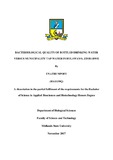Please use this identifier to cite or link to this item:
https://cris.library.msu.ac.zw//handle/11408/3012Full metadata record
| DC Field | Value | Language |
|---|---|---|
| dc.contributor.author | Mpofu, Unathi | - |
| dc.date.accessioned | 2018-04-30T14:10:28Z | - |
| dc.date.available | 2018-04-30T14:10:28Z | - |
| dc.date.issued | 2017 | - |
| dc.identifier.uri | http://hdl.handle.net/11408/3012 | - |
| dc.description.abstract | The most important characteristics of drinking water that have to be assured, monitored and conserved are its safety. Water safety is a growing concern as its quality is not thoroughly monitored especially in third world countries due to lack of proper labs and funding. Unsafe water contains a lot of microorganisms that are a threat to health, most of which contain faecal coliforms that cause serious illnesses like gastrointestinal diseases. Due to the present Zimbabwe water status, there has been an increase in the use of bottled water over municipality tap water. The purpose of this study was to assess the bacteriological quality of bottled water compared to municipality tap water in Bulawayo, Zimbabwe. Six bottled water brands and six samples of municipality tap water were randomly collected. These were subjected to the Total Plate counts, Total Coliform counts and faecal coliform counts. Eight different organisms were observed and these were subjected to gram staining and biochemical tests for identification to genus level. The most prevalent bacteria in municipality tap water included Staphylococcus spp (41,6%) and E. coli (41,6%). Other bacteria isolated from municipality tap water were Citobacter spp (8,3 %) and Entrobacter spp (8.3 %). However, the most prevalent bacteria in bottled water was Staphylococcus spp (58,3%) followed E.coli (20%). Other bacteria found in the bottled water were Streptococcus spp (6,6%), Proteus spp (6,6%) , Entrobacter spp (5%), and Pseudomonas spp (1,6%) and Enterococcus spp (1.6%). The bacterial count means for municipality tap water were lower than these of bottled water. The presence of E. coli in municipality tap water was probably due to water pipe bursts that had occurred recently in some of the areas. Chlorination had low bacterial counts as compared to the other types of water treatment. Most of the faecal coliforms isolated were found in bottled water and this might have been due to ineffective disinfection methods used and also due to the fact that some of the brands were not registered with the Standards Association of Zimbabwe (SAZ) to be selling their product to consumers. It was established that chlorination was the most effective water treatment method therefore making municipality tap water of Bulawayo safer than bottled water. Municipality tap water was able to meet the WHO and SAZ standards as compared to bottled water. This could be fixed by proper monitoring of the disinfection methods and making sure they are registered with SAZ in order to regulate these brands and make sure their products meet the set standards before being sold to the public. | en_US |
| dc.language.iso | en | en_US |
| dc.subject | Bacteriological quality | en_US |
| dc.subject | Drinking water | en_US |
| dc.subject | Zimbabwe | en_US |
| dc.title | Bacteriological quality of bottled drinking water versus municipality tap water in Bulawayo, Zimbabwe | en_US |
| item.fulltext | With Fulltext | - |
| item.languageiso639-1 | en | - |
| item.grantfulltext | open | - |
| Appears in Collections: | Bachelor Of Science In Applied Biosciences And Biotechnology Honours Degree | |
Files in This Item:
| File | Description | Size | Format | |
|---|---|---|---|---|
| UNATHI MPOFU R141139Q DISSERTATION BACTERIOLOGICAL QUALITY OF BOTTLED WATER VERSUS MUNICIPALITY TAP WATER IN BULAWAYO, ZIMBABWE.pdf | Full Text | 911.05 kB | Adobe PDF |  View/Open |
Page view(s)
298
checked on Dec 24, 2025
Download(s)
130
checked on Dec 24, 2025
Google ScholarTM
Check
Items in MSUIR are protected by copyright, with all rights reserved, unless otherwise indicated.



